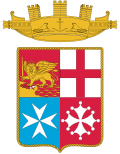 Leonardo A 5301, 2014 | |
| History | |
|---|---|
| Name | Leonardo |
| Namesake | Leonardo da Vinci |
| Owner | NATO |
| Ordered | 19 December 2000 [1] |
| Builder | Shipyard McTay Marine Ltd - Bromborough, England |
| Launched | 3 January 2002 |
| Commissioned |
|
| Homeport | La Spezia |
| Identification |
|
| Status | Active |
| General characteristics | |
| Type | Coastal Research vessel |
| Tonnage | |
| Displacement | 433 t (426 long tons) full load |
| Length | |
| Beam | 15.2 m (49 ft 10 in) molded |
| Draught | 2.76 m (9 ft 1 in) full load |
| Propulsion |
|
| Speed | 10.0 knots (18.5 km/h; 11.5 mph) (sustained sea speed) |
| Range | 1,850 nmi (3,430 km; 2,130 mi) at 8 knots (15 km/h; 9.2 mph) |
| Endurance | port to port, 5 days |
| Complement |
|
| Sensors & processing systems |
|
| Notes |
|
Leonardo (A 5301) is a coastal research vessel owned by NATO and operated by the Italian Navy on behalf of the Centre for Maritime Research and Experimentation [3] Her homeport is La Spezia, Italy.
